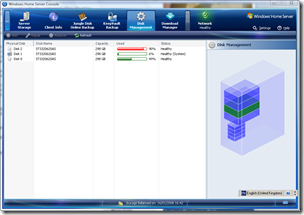Add-In: Windows Home Server Disk Management
Windows Home Server Disk Management is a new add-in which is an extension of the server storage interface, making it easier to identify the hard drives via a visual display. Seeing which drive is the system drive and the amount of data being used on each drive has now become easier.
Features Pending:
The big image on the right will be replaced by a picture of your computer case (as specified by you), with drive bays mapped to disk locations. Select a disk from the list, and the appropriate drive bay is highlighted in the image.
The “Repair” button isn’t hooked up yet; I haven’t been able to figure out how to make a drive fail so I could test my repair code (and I won’t release stuff I can’t test). You’ll still get an “unhealthy” status + icon if WHS thinks the disk is bad; you’ll just need to change back to Server Storage to run the repair.
Notes:
The current WMI crawl is very slow; I’m relying on some Windows calls that aren’t very efficient. With multiple disks, the initial load and any refresh of the add-in may take longer than 1 minute. You’ll see your CPU spike during this time.
WMI doesn’t really know what the underlying hardware is, it can only report back on what Windows thinks is there. If your SATA controller is lying to Windows and pretending to be IDE, your disks will be labeled as IDE.
The download and support information is available from here.
Share this WHS Article with Others:





WHS remains to be a beta testing product…
> The current WMI crawl is very slow.
> The “Repair” button isn’t hooked up yet.
> add-in to identify the hard drives via a visual display.
> You’ll see your CPU spike during this time.
Nice to have add-ins, but obviously not a polished nor finished experience for the customers. Perhaps, sometime ahead, WHS might be working right, and without the data corruption issue which remains without a resolution even still. See: http://www.support.microsoft.com/kb/946676
Why is the WHS drive manager so different than the above add-in when reporting memory? In fact, the creator of the add-in claims, “I believe my add-in is more accurate than the WHS Server Storage tab”.
If actually true, then the Windows Home Server Team needs to explain why WHS is not actually reporting the reality.
I think an explanation would be helpful…
How great is Windows Management Instrumentation when it doesn’t really know what the underlying hardware is?
It seems more and more of the time, software is becoming more script language based, than based upon real efficient, power saving and reduced footprint, like assemble code. Rather than simplification, everyone is building upon yet another higher level language, introducing even more errors, bugs and proprietary code.
Of course, Microsoft claims that the purpose of WMI was to define a non-proprietary set of environment-independent specifications which allow management information to be shared between management applications.
We haven’t got any data so far which indicates that the storage tab from WHS is displaying incorrect information. If that is not the case for any user, please file a feedback through MS Connect and we will look into it promptly. The WHS team specifically wanted to hide the per-disk statistics from the end user since with Drive Extender technology, all the hard disks become a single big pool of virtual storage.